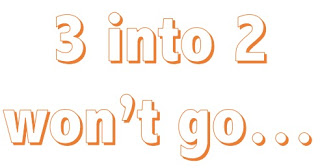| Online: | |
| Visits: | |
| Stories: |

| Story Views | |
| Now: | |
| Last Hour: | |
| Last 24 Hours: | |
| Total: | |
Sexy statistics
By Brian Clegg
I am totally baffled by some statistics that are are frequently used on the average numbers of sexual partners for males and females. It has been in most of the newspapers, and I most recently saw it in New Scientist, where the common numbers of males having 12 partners and females having 8 partners came up. This seems strangely asymmetrical when there are approximately similar sized populations of male and female. And yet, bizarrely none of the articles question this oddity. Neither do the main sources the papers used: the Lancet and the Wellcome Trust.
Let's see if we can make sense of these numbers using a mini model. As always with scientific models we need to be clear what assumptions are being made. Initially I am only looking at heterosexual partnerships – which may be an issue, so I will come back to this later. As we have a ratio of 3 to 2 between the numbers of partners, I'm going to try to set up my model with each male having three partners and each female two. I have a population with six males (A…F) and six females: (1…6).
Let's set up the males with three partners each a couple of different ways, starting with a simple, systematic allocation:
A: 1,2,3
B: 4,5,6
C: 1,2,3
D: 4,5,6
E: 1,2,3
F:4,5,6
Here females 1,2 and 3 have partners A,C,E and 4, 5 and 6 have B,D,F. Not surprisingly, females have the same number of partners as males.
Let's try a more scrambled set:
A: 1,2,3
B: 5,1,2
C:2,3,4
D:1,6,2
E:1,2,4
F:4.5.6
Now how have we done? Here are the females:
1:A,B,D,E
2:A,B,C,D,E
3: A,C
4:C,E,F
5:B,F
6:D,F
Aha, it's no longer symmetrical. But take the mean and once more the females have an average of 3 partners. So without homosexual partners it's difficult to make the maths work. Here's an arrangement that does produce the right ratio:
A: 1, 2, 3, B, C
B: A, C
C: A, B
D: 1, 2, 3
E: 4, 5, 6
F: 4, 5, 6
Unless someone can clarify where I've gone horribly wrong here, I think all those newspapers (and New Scientist), the Lancet and the Wellcome Trust) announcing that on average males have 12 sexual partners and females 8 are simply getting the facts wrong. Admittedly the original press release said that for instance 'males reported 12 partners', but this quickly became 'on average men have had 12 partners.' However, what they really should be reporting is that people don't tell the truth about the number of partners they have and because of this, these numbers are useless, except as a study of the psychology of lying.
Now Appearing is the blog of science writer Brian Clegg (www.brianclegg.net), author of Inflight Science, Before the Big Bang and The God Effect.
Source: http://brianclegg.blogspot.com/2015/10/sexy-statistics.html




